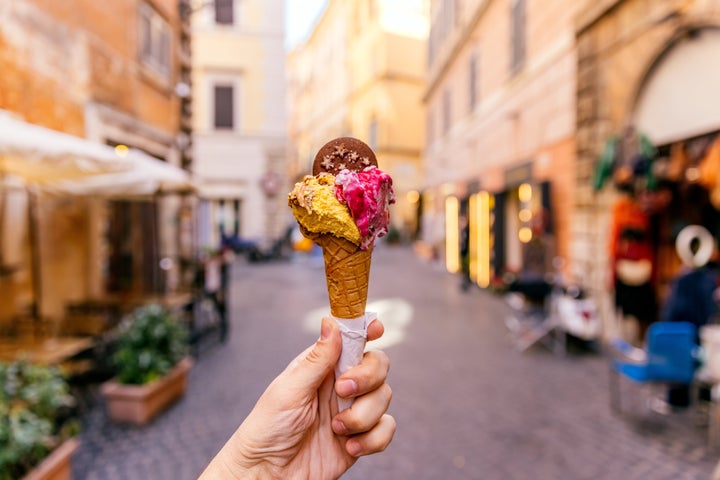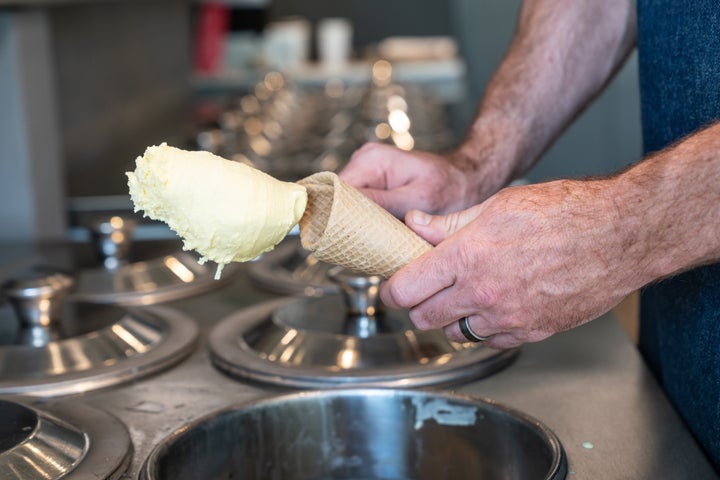
All summer, Americans have been flocking to Italy to enjoy the fresh pasta, pizza and, of course, plenty of gelato. The latter has a particular hold on American travellers, many of whom declare that the frozen treats they tried in Italy were far superior to the ice cream they eat in the United States.
But technically, “gelato” is just the Italian word for “ice cream.” So is there actually a difference?
“The first thing to know is ‘ice cream’ has a legal definition in the code of federal regulations in the U.S.,” said Douglas Goff, a professor emeritus in food science at University of Guelph. “The legal definition specifies a minimum content of milk fat and milk solids.”
The United States Department of Agriculture’s standard for ice cream requires that products using this label contain at least 10% milk fat, also called butterfat, and 20% milk solids. Ice cream must contain at least 1.6 pounds of total solids to the gallon and weigh at least 4.5 pounds to the gallon as well.
Gelato, on the other hand, is not subject to any such requirements in the U.S. (Members of the Italian parliament have introduced a bill that would regulate the process and composition of what can be designated as artisanal gelato in that country, however.)
As a result, there’s more latitude to what you can produce and market as gelato. Still, dessert experts tend to follow some general norms and criteria.
“Gelato is a lower fat frozen dessert, and it typically ends up being somewhere around the 4-7% fat mark,” said Steve Christensen, executive director of the North American Ice Cream Association. “Usually when you have less fat, you have less air, also known as overrun. So with less fat and less air, gelato is generally a lot richer and denser than a higher fat ice cream.”
Basically, both desserts contain some combination of milk, cream, sugar and some sort of flavouring, but the proportions are not the same. Ice cream is also more likely to have eggs as an ingredient.
“Gelato is ice cream, but with more milk than cream and less eggs,” said award-winning chef and Milk Bar founder Christina Tosi.
She added that gelato is churned at a slower rate and with less intensity, which means less air is incorporated. As a result, it’s got a thicker, creamier texture whereas ice cream is much fluffier.
This difference in composition affects the way the flavours permeate each frozen treat. Some experts believe that gelato’s denseness, lower butterfat content and difference in ingredient sourcing means its flavours are more intense.
“If you’ve ever been so fortunate to have gelato in Italy, it probably tasted ‘better’ than anything in the states,” Tosi said. “This is probably because of recency bias, Italian romance (we’re all victims to vacation pulling at our most ideal heartstrings), and because dairy, in Italy specifically, has a totally different pasteurisation standard. The milk is not heated as high so essentially the dairy going into the gelato is more ‘flavour-filled.’”
On the other hand, ice cream can be better for a long-lasting taste experience.
“For ice cream, more fat means a more decadent experience,” said Tyler Malek, co-founder and head ice cream maker of Salt & Straw. “With a fattier base, ice cream holds flavours to your taste buds longer and more intensely, making it perfect for expensive ingredients like organic dark chocolate and vanilla bean. Gelato is lower in butterfat, so it doesn’t get in the way of more delicate flavours, like strawberry and pistachio. When we’re working with a more delicate flavour, we’ll approach it as a gelato or sherbet to really let it shine through.”
Gelato makers typically gravitate toward classic Italian flavours like stracciatella, pistachio and nocciola (hazelnut). There’s a little more experimentation in U.S. ice cream with unusual flavour combinations and mix-ins.
“I’m a very ‘more is more’ ice cream pint shopper,” Tosi said. “Big swirls and gobs and goo ― that’s what I look for. When I eat ice cream, I want it to count.”
Ice cream and gelato also differ in terms of the optimal temperature for serving. Gelato requires a slightly warmer temperature to preserve that creamy, elastic-like texture, while ice cream would melt and become too soupy in those conditions.
“Because it is so much lower in fat and has little to no eggs for stabilisation, in order to be at its best taste, [gelato] must be served within 24 hours of its production,” noted Ben Van Leeuwen, CEO and co-founder of Van Leeuwen Ice Cream.
It’s worth noting, however, that ice cream aficionados would say the treats at an ice cream shop are best served within 24 hours of production as well.
Still, there’s a reason why you see tons of ice cream offerings in the freezer aisle of the grocery store and even for purchase at ice cream shops but don’t see a lot of gelaterias selling frozen pints. Ice cream is hard frozen, so it lasts longer.
“Many gelaterias sell their product in a five-litre pan called a napoli,” Christensen noted. “So the rotation of product is a lot faster, and you’re always eating something that was made very fresh versus something that’s been sitting at the bottom of a three-gallon bucket for a week.”

Stainless steel napoli pans are typically rectangular, but there’s also a storage option called pozzetti, which refers to rounded tubs made of the same material. These come with lids that cover the gelato and protect it from ambient air and humidity.
“The first sign of a delicious gelato is not being able to see the gelato in the freezer case,” Van Leeuwen said, referring to the artisanal gelaterias that keep the lids on their containers.
“The other telltale sign of mediocre gelato is when it is piled high in the case with intricate candy bar typed ingredients piled on top,” he added. “Generally when it looks like this, it is being made in the shop, but with industrially produced bags of powdered mix and pre-made add ins.”
He believes this approach leads to gelato that is not artisanal, tastes overly stabilised and overly sweet, and lacks the punch of flavour in higher quality products.
“In Europe, many gelato makers are following family recipes and pasteurising their own mix right there where they make their gelato,” Christensen said. “That artisan process of sourcing ingredients, cooking the mix and then taking it straight from their pasteuriser to the ice cream machine isn’t as common in the U.S. as in Europe. The fresh and bespoke nature of gelato throughout Europe is incredible.”